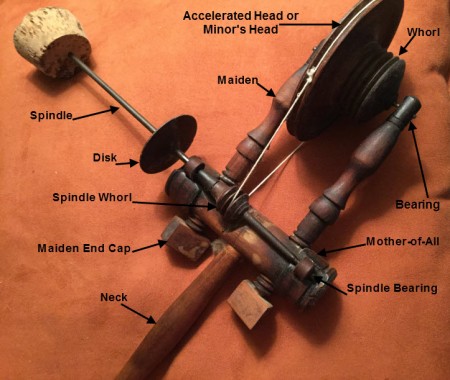Great wheel, walking wheel, spindle wheel. The name changes but the principle stays the same. These are large wheels that the spinner typically stands to spin on. A large drive wheel is mounted on an upright post, while the spindle post holds the spinning head. As this is a smallish, removable part, it often goes missing from old wheels. Here is what you need to look for if you need a spindle head, or what you have if you have found one, sans wheel!
The neck mounts the assembly into the spindle post and supports the Mother-of-All, or MOA. Just as with a flyer wheel, the MOA supports the maidens. Since the maidens usually have a screw turn so that they may be leveled, the bottom of the screw has a little wooden cap to protect the threads and prevent the maiden from being unscrewed past a certain level.
The spindle itself is an iron rod about 12 inches in length. It may or may not include a little wooden disk; this helps prevent the spun wool from creeping back into the bearings. The bearings that hold the spindle to the MOA may be from leather thongs or braided cornhusk. The spindle has a whorl — if your wheel has an optional accelerated head, such as the one in the illustration, the whorl will have a secondary drive band connecting it to the accelerating head. If you had a direct drive wheel, you will have only this one whorl on the spindle and the drive band will connect to the drive wheel.
With the accelerated head, each maiden has a small wooden bearing that holds the head’s axle ends. The whorl of the accelerated head holds the drive band that connects to the drive wheel. This 19th century invention was developed in order to help a spinner spin faster.
Just as with flyer wheels, there are many different styles of spindle wheel and of spindle heads. This is a generalization to help get you started or to help you find what you need!

You must be logged in to post a comment.